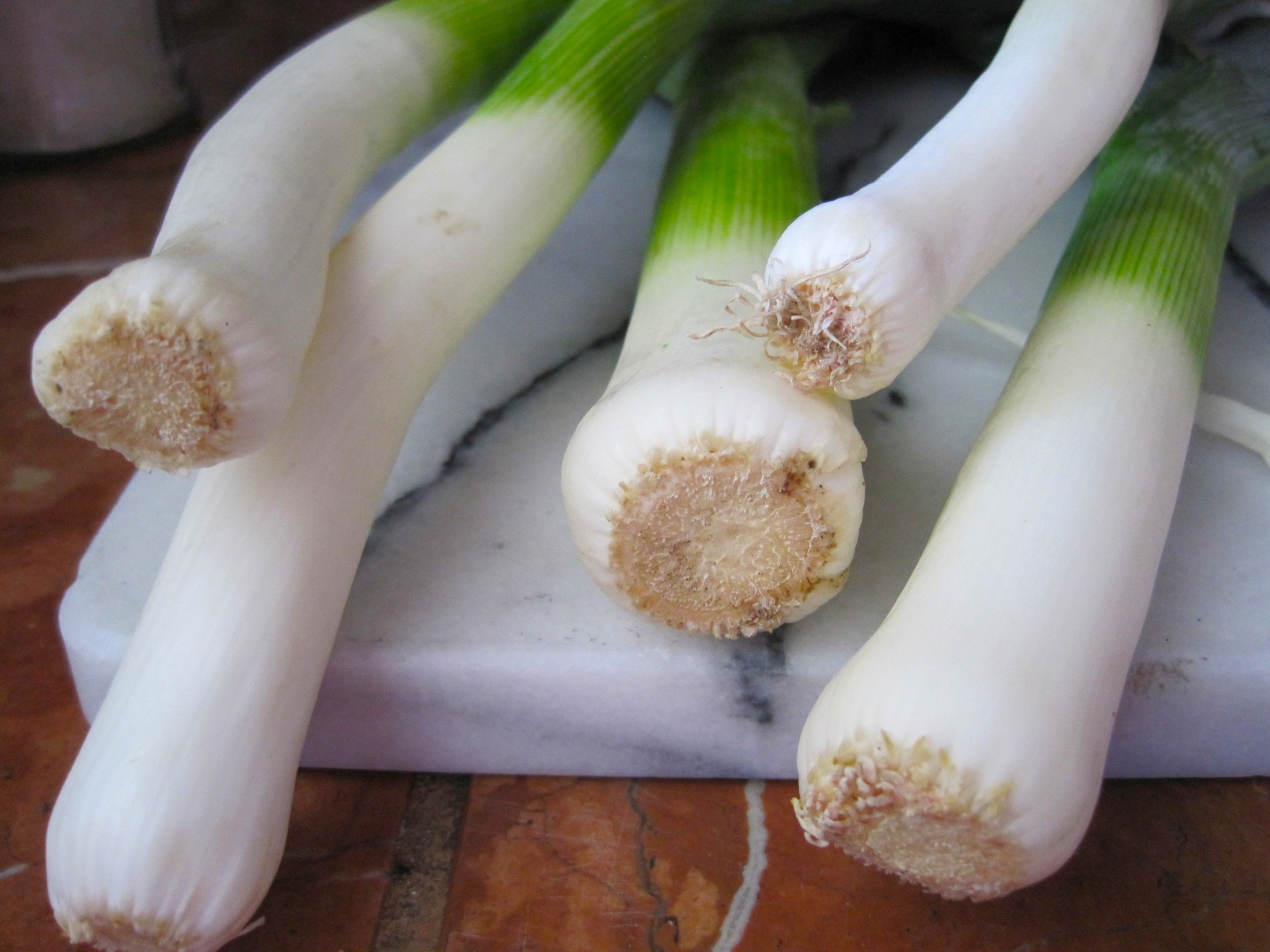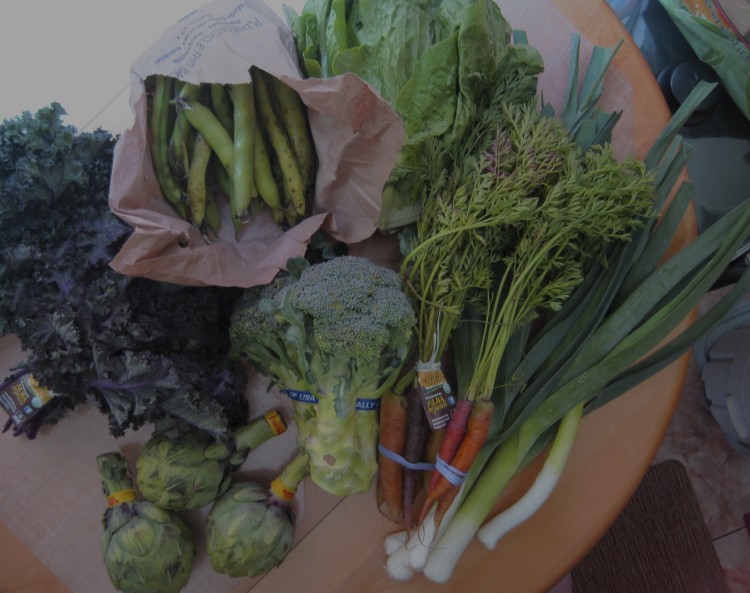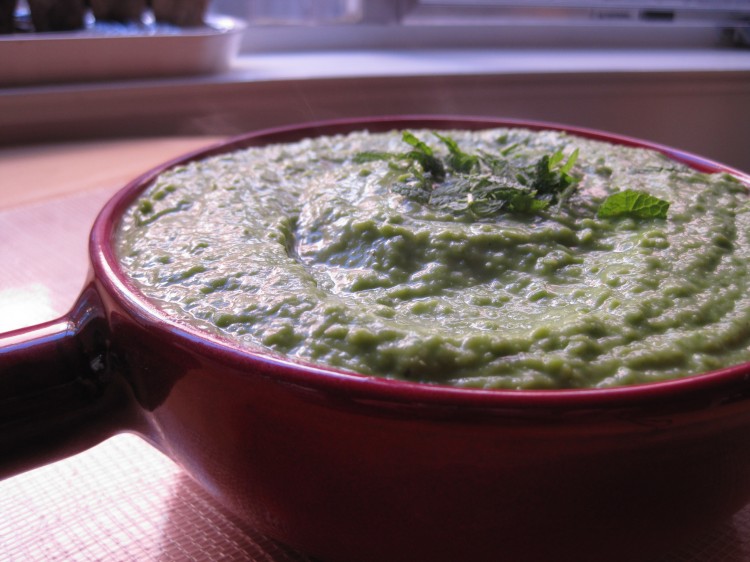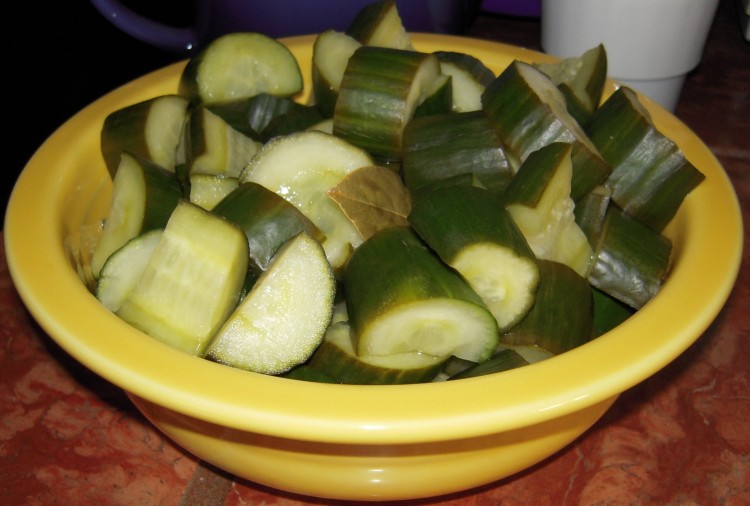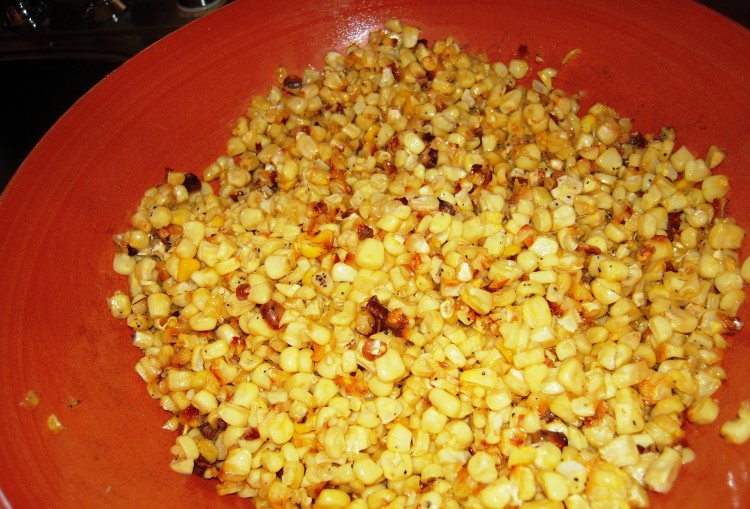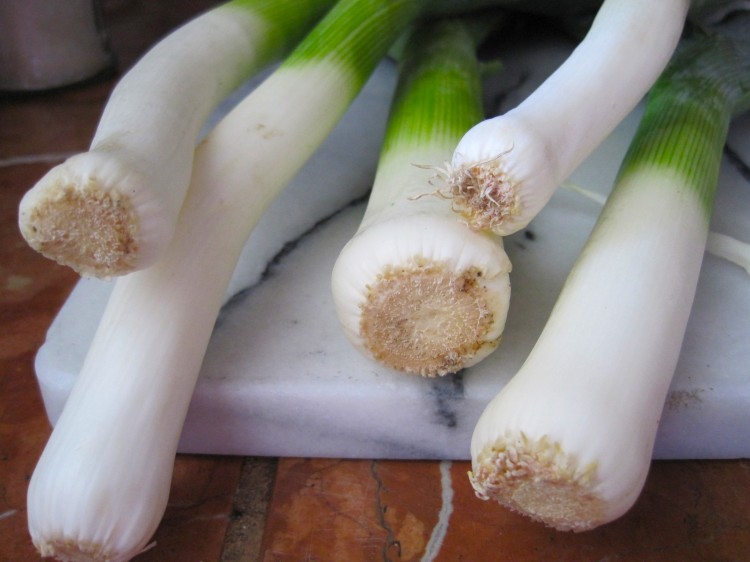
These are the leeks that came with my CSA box last week
The first installment of my CSA series covered quite a bit of ground about what the CSA concept is all about, and a bit about the company I chose for my own home-delivered organic produce: Albert & Eve.
Let me now tell you what and how much was in my first box, which arrived last Thursday. There’s a photo of the contents here.
1 huge romaine lettuce
2 bunches of rainbow carrots
1 large broccoli
5 massive leeks — so long I had trouble fitting them in the fridge
2 bunches red bohr kale
1 bag fresh fava beans (about 15)
3 medium artichokes
It all came in minimal packaging: a paper bag with the odd inner bag or two, one plastic.
Everything was fresh as can be and looked and smelled great.
Now, here’s where you have to plan a little based on shelf life. Artichokes and broccoli can hang around for a good week. The lettuce was already slated for a family-sized Mexican entree salad for that same night — and a lunch salad the next day for my son — so I had to think about leeks, kale, carrots and favas.
The favas and carrots were in quantities fit for one side or one snack each for the four of us. The kale could make a meal if I used both bunches, or two sides, if I used one at a time. The tremendous leeks would serve as the base for two meals: one using the tender parts, another using the tougher end greens.
First up on the chopping block: leeks. If you haven’t hung with many leeks in your life, they’re related to onions and garlic, but are much milder. They look like really big scallions. Only the white and light green parts are eaten and the rest is used for stock.
They’re popular in the UK — especially Wales, and often show up in soups.
I decided on a leek and feta scramble. With preserved lemon, which I always have in spades because my lemon trees are good to me.
A little sumac, too. Sumac is a tart spice made from dried berries — very popular in the Middle East. It’s generally sprinkled on top of finished dishes.
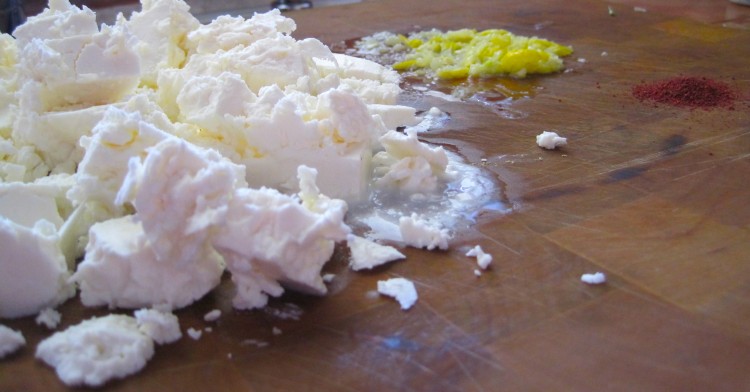
Feta shards, sumac and chopped preserved lemon for the scramble
A recipe accompanies this post, but the idea is to chop the tender part of the leeks, saute until soft, add whisked eggs and cook so that you have large, soft curds, adding the feta and seasonings at various stages.
Please purchase blocks of sheep’s milk, or sheep’s/goat’s milk feta — in brine, if you can — and not the cheap, tasteless, pre-crumbled stuff so popular these days. Good feta should be salty and tangy with real mouthfeel. If you buy fat-free feta, well, you’re going to be sorry. When dishes have only a few ingredients, you need them to be the best they can be. Just sayin’ — don’t mean to be preachy, but better to have a little real feta in there rather than lots of the cardboard kind.
Pastured eggs would be a good choice here, too. They taste like eggs used to taste, because the hens producing them roam around and eat bugs and worms and whatever else they like to peck at in addition to their feed. If you can’t afford them for general use, spring for them when you’re making a scramble or some fried eggs. You’ll really enjoy the taste of their deep yellow yolks.
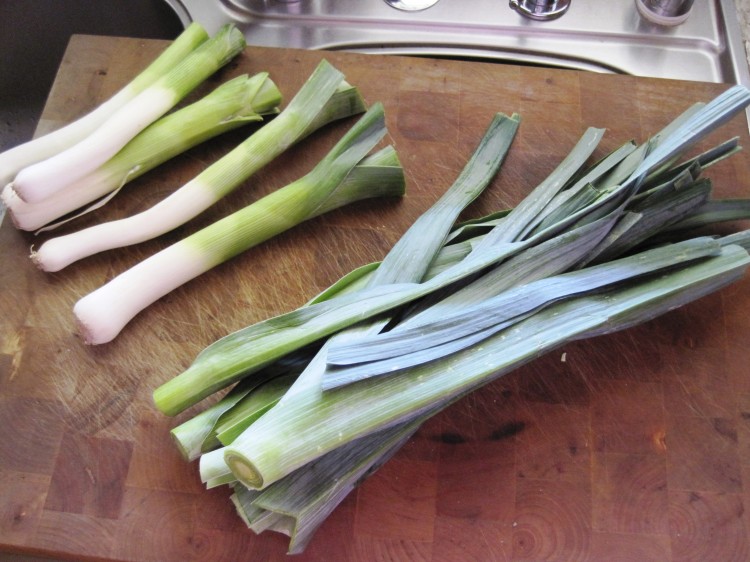
OK, leek prep.
Once you trim and liberate the tender from the tough, as in the photo above, store the latter back in the crisper.
Then clean the leeks by cutting them lengthwise all the way through from about a half-inch from the bottom. Then make a similar cut between your original cut, which will ribbon the leaks, allowing you to clean nooks and crannies as you flagellate them in a sink full of water.
Then you can dry them off and chop away.
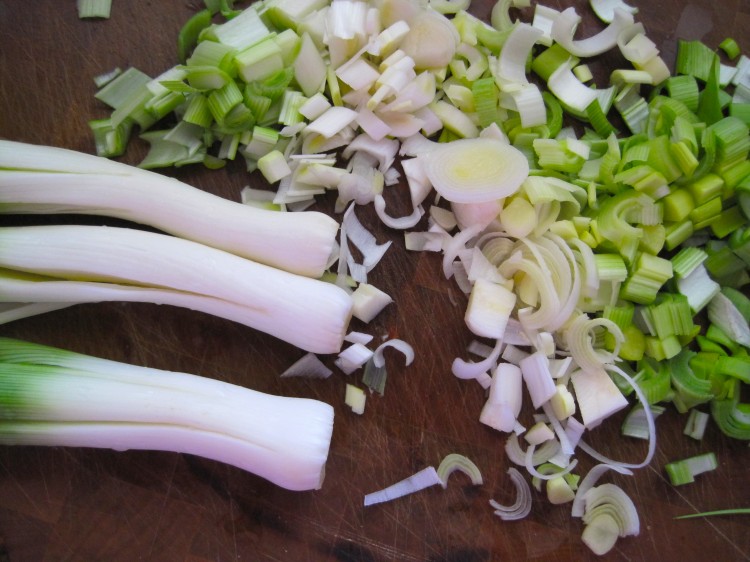
Then saute slowly until soft.
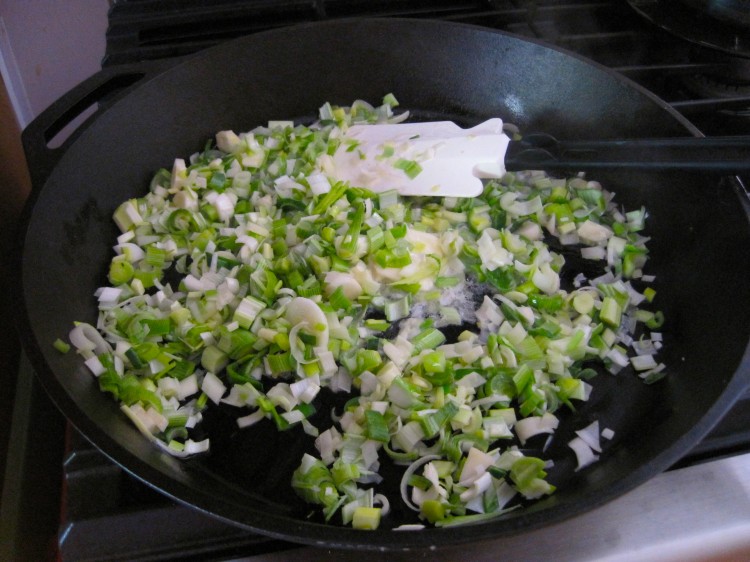
Then add everything else in stages. I sometimes add the cheese along with the seasonings, as I did here, but generally I add it as indicated in the recipe — right at the end. This time around the cheese was on the dry side, so no worries about it releasing too much brine during extended cooking.
 We were so happy about the soft, mildly-oniony scramble that I neglected to photograph the finished product — which we consumed with a side of good toasted bread, which is all you need. The addition of the sumac and lemon added a whisper of citrusy tartness to the salty, creamy, funky feta backbone.
We were so happy about the soft, mildly-oniony scramble that I neglected to photograph the finished product — which we consumed with a side of good toasted bread, which is all you need. The addition of the sumac and lemon added a whisper of citrusy tartness to the salty, creamy, funky feta backbone.
Trust me, it looked good, too.
Tune in next time for favas.
- 4 to 5 leeks, chopped (the white and very pale green parts only)
- 2 tablespoons canola oil, or more, if your leeks are large
- 2 tablespoons butter, or more, if your leeks are large
- 10 eggs
- ½ pound feta cheese, broken into medium shards
- 2 tablespoons preserved lemon, finely chopped (If you can't find jarred Morrocan preserved lemon, just chop a quarter of a lemon finely, mix with a ½ teaspoon of kosher salt, and store in fridge overnight)
- ½ teaspoon sumac
- Kosher salt
- Ground black pepper
- Add canola oil and butter to a large, heavy skillet over medium flame
- When hot, add leeks and turn flame down to low
- Add a little salt
- Saute leeks until nice and soft
- Whisk eggs with a little water (water will help soften them), the lemon and the ground pepper
- Add egg mixture to pan over leeks
- At short intervals, pull eggs from the bottom of the pan with a spatula to form large curds
- When eggs are still quite runny, gently mix in feta
- Keep pulling up the eggs gently until the feta is very soft
- Remove scramble to serving platter and sprinkle with sumac
- Serve with good toasted bread

